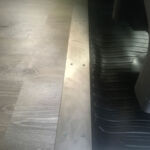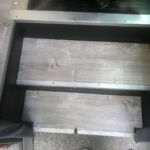
So after we painstakingly installed the floor in the Grand Ballroom of the bus (disco ball coming soon), we had to turn our attention to the entryway. After all, if the foyer of the mansion is a mess, nobody’s going to want to see the rest. Well unless, y’know, curiosity. That said, last time we saw Steph in Beast Mode tearing up the stairs. Once she freed the old steps from their earthly confines, we discovered that that hole in the bottom step that went clear to China. We fixed that in the previous round with the POR (paid link) and Bondo Fiberglas stuff.
Now that the floor of the cab was solid structurally once again, it was time to gussy up the joint. We started by continuing the ballroom flooring onto the steps, which helped tie in the look and feel of the rest. We painted the rise and ‘walls’ of the steps a satin-ish black, which also ties in with the fixtures, and other factory things, like the dashboard and the floor mat. The mat had endured nearly two decades of prep school field trips, lacrosse, soccer games, and what have you. It was time for it to go.
Your average factory-built conversion vans of the era came equipped with a carpeted floors up front that typically matches the carpet in the back. While carpet is great for sound deadening and adding that ‘luxury’ feel to conversion vans, we wanted to keep ours as weatherproof as possible so that we could ultimately hose it out if we had to, without attracting the mold levels of a bogged down fan boat in a Louisiana bayou.
Sounds easy enough, right? Buy a new floor mat and slap it in there. Nope. Not so much. To clarify a little, this mat covers everything in the cab with a thick rubber mat, insulated with what looks like asbestos from a World War II aircraft carrier and cat hair. It’s big. It’s heavy. It’s expensive. Upwards of $150 at the time. Being mindful of the budget, that was a no-go, which ultimately meant a trip to the junkyard, which normally, I love. In this case though, I kind of already knew what was in store for me.
For those uninitiated, junkyards, salvage yards, or the yuppie term, auto recycling centers, are magical places where you can potentially get awesome used parts for pennies on the dollar. And sometimes if you buy enough stuff, they throw in the smaller parts for free. For example, I was able to buy a brand-new exhaust system for the Xterra for about a quarter of what it cost new. Because I bought that, I was able to to get a trim-level’s worth of stuff for free, like little pocket nets, industrial strength cargo hooks, hardware, and the like, that would have cost the original owner several hundred bucks. Fun, right?
Right. But, since we were looking for the industrial strength cargo van floor mat, that meant I had to enter the cabs of several recently retired cargo vans. These are commercial rigs that see several different drivers rushing from job to job, idling all night sometimes, and definitely feature that ‘lived-in’ look. More often than not, these cabs should be covered in police tape and HAZ-MAT warnings. They are usually blown out war-scapes with cigarette burns in the headliners and seats, cracked out dashboards, coffee cupholder consoles that sometimes still have coffee in them, and the remnants of donut ghosts that litter the floor. The mice have been in them and the raccoons have been in them — and in some of them, detectives could still swab viable DNA samples from three murders ago.
Wrapped in seven layers of rubber gloves and three layers of old clothes that I could burn after, I marched myself to the Pick-N-Pull. Expecting the worst, proceeding with caution, and hoping for the best, this time, the latter won. After the first rig, which I’m pretty sure had an exorcism performed on the dashboard, I found the holy grail. Dejected, I opened the driver’s door, expecting that haunted-house rusty squeak, but found it opened smoothly, like new. I peered in, holding my breath with anticipation (mostly self-preservation related to air quality), and found it: A gorgeous black vinyl floor mat that was full-width, full-length, thick, industrial-strength, and looked completely new. I swear I heard a pipe organ. And it got even better. The thing was just sitting there, flat. The seats were already gone. The trim was already gone. It was clean. No donut ghosts. No coffee rings. No DNA samples. Hmmm. Then I was suspicious. Why was it so clean? Was it recently bleached and scrubbed of fingerprints? Nay, here’s why. This particular van was a former florist delivery rig. No heavy construction, no scrap runs, no transportation of medical waste. Just water and topsoil and someone clearly had swept it out before dropping it off here. Truly, a junkyard miracle. To top it off, the person who took the seats didn’t take the hardware. But I did. It’s always good to have big, spare, Grade 8 hardware in stock when building a bus — especially when it’s free. When I rolled it up to put it in the cart, even the insulation was clean and dry and warm and comforting as an Irish sweater. All for 10 bucks. Scrapyard Gold, laddie.
So we spruced up those stairs, installed the holy floor mat, and now it was time for some trim to tie it all together, like a good home reno show would. While at our other favorite scrap place, the Exeter joint down the road, we found some great pieces of angle iron for the step edges, and a nice, big, flat piece of aluminum to cover the transition from the foyer to the Grand Ballroom. This is also where the ‘cutaway’ part of the bus happens. You can see where the factory GM floor ends and the Corbeil bus part begins, so this was a great place for a nice threshold-y type transition.
As it turns out, the stair trim was actually steel. A little heavier than aluminum, but still light enough, as we didn’t use a lot in that area. It just took a little more to drill the holes, as aluminum cuts like wood, steel cuts like, y’know, steel. Also as it turns out, the aluminum threshold transition piece was also not aluminum. And it wasn’t just steel, either. It was stainless steel, the hardest known metal in all of the dang universe. Seventy-seven drill bits, four grinder discs, and a week’s worth of truck-stop swearing later, we finally installed the threshold and a presentable foyer.
Speaking of scrapyard miracles, tune it next time when we sprinkle some pixie dust to craft a co-driver’s seat where one never was before!




